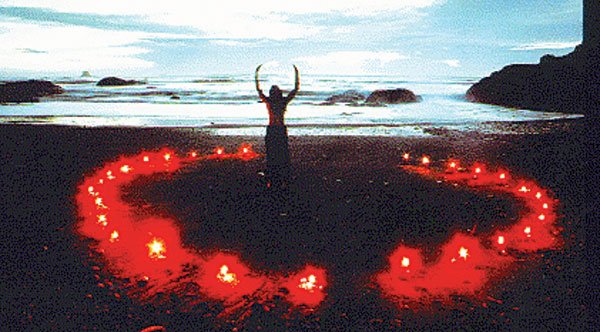Marian blends seamlessly with the other residents of her San
Jose mobile home park, her petite frame swathed in a pink cotton
sweater and her short blonde hair waving around her ears.
Marian blends seamlessly with the other residents of her San Jose mobile home park, her petite frame swathed in a pink cotton sweater and her short blonde hair waving around her ears.
She offers visitors tea, points to pictures of her granddaughter and a young local girl who loves to come by for afternoon visits. She tells jokes that end in a flourish of her right hand and a single, sharp, “Ha!” for emphasis, then fixes her shrewd gaze on the recipient and waits to gauge their appreciation.
Yes, Marian is almost like the others, but she is also hiding a secret in plain view. Look above the front door, or on the wall of the kitchen or the back porch. There are signs everywhere for the observant: Marian is a witch.
For the last 30 years, this frugal, pragmatic and independent woman has practiced Wicca, a pre-Christian pagan religion dedicated to bringing man into harmony with his environment.
The practice originated in Northern Europe, primarily in the British Isles, where agrarian societies worshiped not only a male deity in the form of the potent sun, but the fertile qualities of the land in the form of the Goddess, the high deity of their belief system.
Steeped in mysticism and ritual, this polytheistic form of spirituality has no central church, no solidified doctrine.
Individual practitioners and groups called covens all worship in different ways, lending an inconsistent air to their practices as a whole. However, a few tenets do remain the same. Wicca stresses personal responsibility, reverence for nature and a lack of discrimination based on sex, color, age or religious belief.
Believers practice ritual magic based on the wheel-shaped pagan solar calendar. Some cast spells while others divine, practice alchemy or utilize other forms of supernatural manipulation.
The pentacle – a five-pointed star – is also a constant symbol, representing the five points of Wicca – spirit, earth, air, fire and water.
Worn with the odd point facing up it represents the triumph of spiritual forces over the other elements. Worn down it becomes a symbol of the rule of earthly elements, a threat and a subversive gesture to many Wiccans.
Marian was looking for a vent, something that she could explore her own worldview through, when she stumbled on Wicca in a book of comparative religions she’d checked out from the library.
Attracted to the ideas of using herbs for healing, reverence for natural things and conservation, she began her studies.
“I think the thing that really attracted me in the end was that in Wicca you are responsible for what you do – not society or your parents or the teacher in the fifth grade, but you,” said Marian. As her friend and covenmate Bella said, “The buck stops here.”
Many Wiccans, like Marian and Bella, do not use their real names publicly. They cite fear for their personal safety, for their reputations and their jobs, finding it better to remain anonymous than “to wonder why your windows keep getting broken.” Roe Griffith, who maintains the coven of Circle of the Sacred Feathers in Hollister, said the group keeps a low profile because of misconceptions.
While none of the women interviewed for this story shared personal encounters with violence or hostility, the practice of Wicca remains a volatile issue. Witchcraft laws have been slow to come off the books in a variety of countries and states. Witchcraft became legal in England in 1951 and in Italy in 1981. It became a recognized religious belief in the United States in 1986, but as late as 1999, schools were able to ban the wearing of pentacles as religious jewelry. Detroit high school student Crystal Seifferly won that right, but schools may still forbid the wearing of a pentacle by students who do not identify it as a religious symbol.
In May 1999, U.S. Rep. Bob Barr, R-Ga., a serving member of the House Judiciary, Government Reform and Banking committees issued a press release titled “Causes of youth violence found in adult culture” in which he called on the government to ban Wiccan soldiers in Fort Hood, Texas, from practicing their religion.
Then-governor George Bush agreed, saying, “The military should rethink their position. That’s not a religion.”
“We’re a private group, and we don’t actively recruit,” said Griffith. “We1re not into human sacrifice or teenage sex. Everyone’s got to be over 21, because we have to be so careful about things. I don’t like weirdoes. There is (a misconception about Wicca), but only because no knowledge is fear. We don’t wear black with long red nails and go prancing down the street.”
When most Americans conjure the image of a witch, it’s that from a Hallmark card – some scary old crone carrying a broom with a long nose and repulsive skin.
The word “witchcraft” brings to mind teens who paint their fingernails black, wear inverted pentagrams and cast menacing glances at their elders. But most practitioners of Wicca are none of these things.
They live by one rule: The Wiccan Rede, which states “An it harm none, do as thou wilt.” In other words, “do what you want as long as it doesn’t hurt anyone.”
Some groups add a second rule, called the “Rule of Three” to their practice.
In a adoption from karmic traditions, it says that anything done for good or ill will be revisited on the person who wished or did it three times, much like the Biblical reference to “reaping what you sow.”
The idea is often unpopular with parents, since many Wiccans come from traditional Christian households, but it’s gaining in popularity among teens.
Since there is no central church or official database for Wiccans, it is nearly impossible to know the number of their ranks.
Articles postulate everything from 1 million worldwide to slightly more than 3 million in North America alone, but one thing is certain: Their most rapidly growing demographic is teenage girls. The Witch”s Voice (www.WitchVox.com) is one of the most visited religious sites on the Internet according to a survey by HitBox.com. Of those visiting the site, 62 percent were female and three out of five were under the age of 30.
“In the last six months I have received more inquiries about Wicca than any other religion in the last 10 years I have worked here,” said Danny Aguirre, spokesman for the Spiritual Counterfeits Project, an evangelical Christian organization based in Berkeley, Calif., that attempts to pull people away from Wicca and other new-age or alternative spiritual movements. All callers have been teenage girls, according to Aguirre.
Perhaps their interest comes from the idea of having someone like them, someone in whose image they were made, to talk to. The form of the Goddess offers an important female deity as opposed to the patriarchal form that appears in the text of Christianity, Judaism and Islam. Wiccans believe that the Goddess rules over and spiritually fills every material object.
“What I like about being a pagan is that I find company in everything,” said Bella. “You could have a conversation with a humming bird or thank a tree for the apple it gave you. You don’t need someone to help you talk to God because we’re all God1s children, and who ever needed permission to talk to their mom and dad?”
Because Wicca incorporates other deities, the spiritual quest can change with them, too.
“I was raised Catholic and it has all that high ritual and magic,” said Bella. “I had my favorite saints, and I would talk to them. As I got older, I realized there was a lot of guilt and shame, a lot that I didn’t feel in my heart. I don’t have that anymore. We’re all talking about the same thing, even if it’s a different name.”
In search of God’s true heart, perhaps the thing we all really seek is acceptance.
The History of Yule
The winter solstice (Dec. 21) will mark one of the eight major holidays of the pagan year. Held on the longest, darkest night of the year, Yule is a solar celebration heralding the birth of the Sun which will miraculously return to bring new life to the planet in the spring.
Early pagans were subsistence farmers, dependent on the land to produce each spring what they needed in order to survive. By December, food stores would begin to get lower and firewood would be more scarce. In defiance of this depressing time and in hope of the bountiful season to come, pagans would “go out into the forest and find the biggest, fattest tree they could, and cut it down,” said Roe Griffith, who maintains the coven of Circle of the Sacred Feathers in Hollister.
After bringing the tree, known as a Yule log, inside, it was set on fire, becoming the center of a great feast that lasted until its last embers died – as many as three days later. Just before sunrise on the last day, pagans would go outside and sing the sun up, heralding the light that would bring them crops for the new year.
Many of the Christmas traditions that we maintain today trace their roots to these ancient people, among them the traditions of evergreen decorations, the Yule log, caroling, the Wassail Bowl (a traditional caroler’s drink in Europe) and the color scheme that survives to this day: Green for life and new growth, and red to represent the Lord of Light and the power of the sun.













